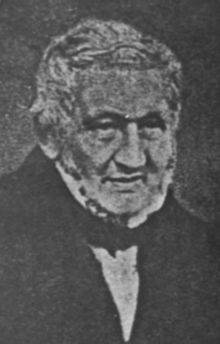Timothy Burstall
Timothy Burstall (* 1776 in Lincolnshire ; † December 7, 1860 in Glasgow ) was a British engineer and pioneer in the field of locomotive construction .
Life
There is only fragmentary information about Burstall's life and work. In 1824, together with John Hill , he built a two-axle street steam car for passenger, freight and mail under the company name Burstall and Hill of London , which they acquired in the following year with patent no. 5090 from February 3, 1825. During test drives, however, it was found that the machine was not able to withstand the vibrations caused by the poor roads and suffered excessive damage.
In 1826 Burstall and Hill received another patent (No. 5405 from August 22nd) for a three-axle steam car, in which the boiler was to rest on its own underframe separately from the car body . In October of the same year, this second steam car reached speeds of up to 6 miles per hour during test drives on Ferry Road in Glasgow . In late July 1827, the car's boiler exploded while driving on a property on Westminster Road in London , injuring John Hill's younger brother.
In 1829 Burstall built the Perseverance (endurance) locomotive to take part in the Rainhill race . However, the machine was damaged in transit when the horse-drawn heavy freight car overturned on the road to the test track. Burstall spent five days repairing the Perseverance while the other locomotives were already being checked . When he finally got it ready on the sixth and last day, it turned out to be far too inefficient: While the winning machine Rocket with a pulling load of 13 tons had reached a speed of 30 miles per hour (48 km / h), Burstalls managed The locomotive was only 6 miles on the first test drives without a load and thus remained well below the required minimum speed of 10 miles. Burstall then withdrew his machine from the competition and was awarded an extraordinary expense bonus of £ 26 .
After the failure in Rainhill, Burstall no longer appeared as a locomotive designer and references to his activity are sparse. In 1841 he worked as a civil engineer in Somerset , and in 1860 he died in Glasgow.
family
Burstall was married twice: in 1806 he was married to Charlotte Radwell in St. Martin-in-the-Fields Church in London , and on November 14, 1825, he married Mariann Price in Leith . The second marriage resulted in two sons in 1830 and 1838, both of whom were named Timothy like their father.
literature
- Chapman Frederick Marshall: A History of Railway Locomotives down to the End of the Year 1831 . The Locomotive Publishing Co. Ltd., 1928
- William Fletcher: Steam Locomotion on Common Roads . E. & FN Spon, 1891
- James W. Lowe: British Steam Locomotive Builders . Guild Publishing, 1975
- Christopher McGowan: The Rainhill Trials . Little, Brown Book Group Limited, 2004
Web links
| personal data | |
|---|---|
| SURNAME | Burstall, Timothy |
| BRIEF DESCRIPTION | British engineer |
| DATE OF BIRTH | 1776 |
| PLACE OF BIRTH | Lincolnshire |
| DATE OF DEATH | December 7, 1860 |
| Place of death | Somerset |


